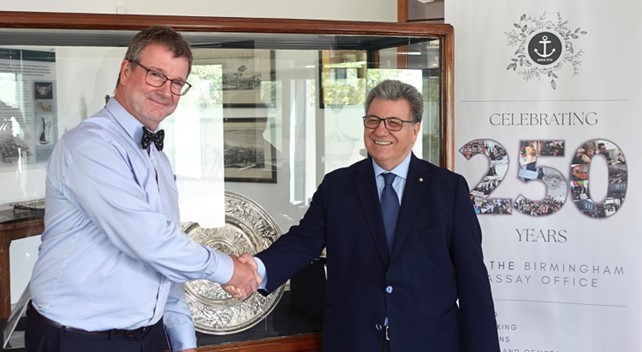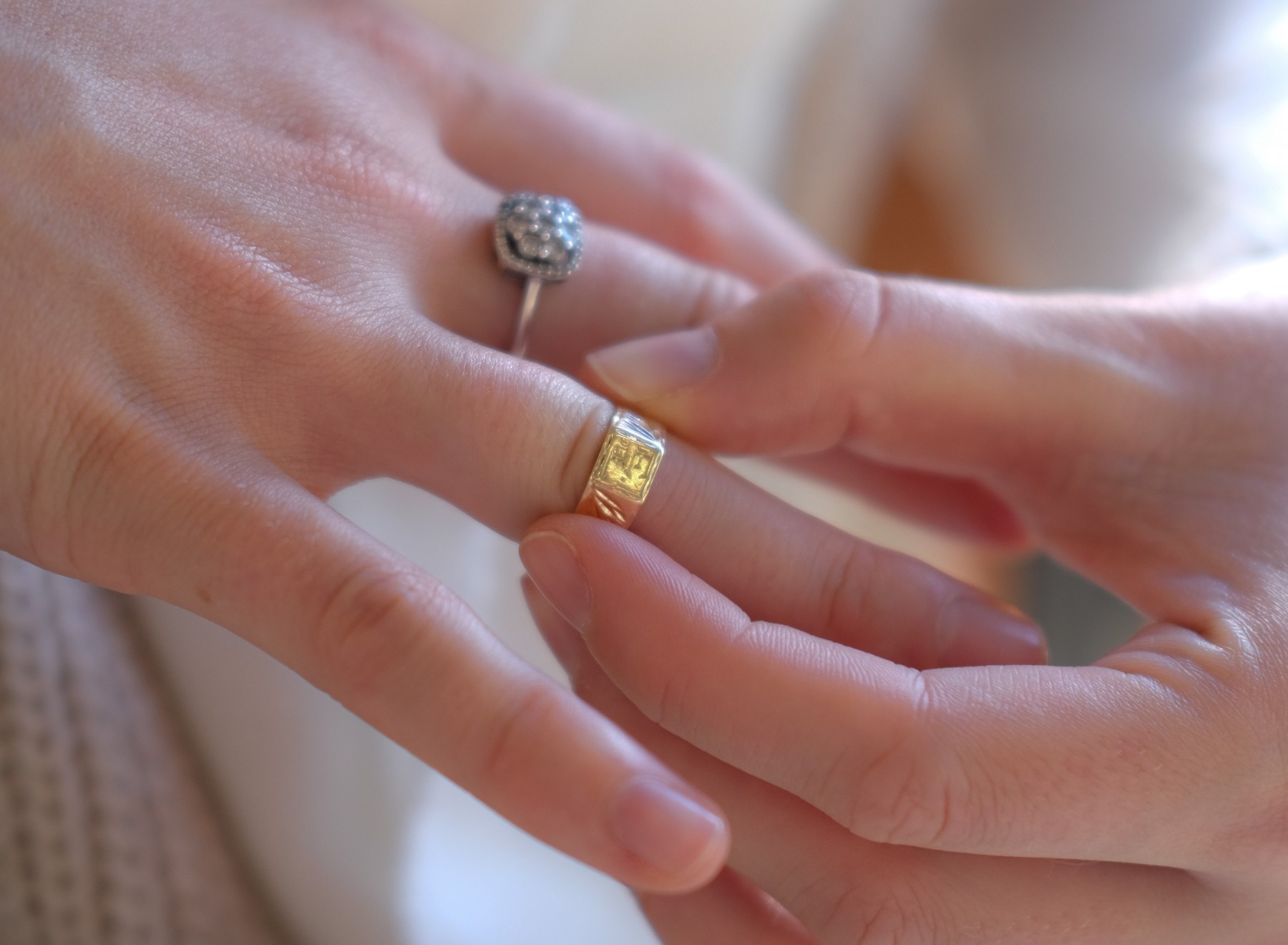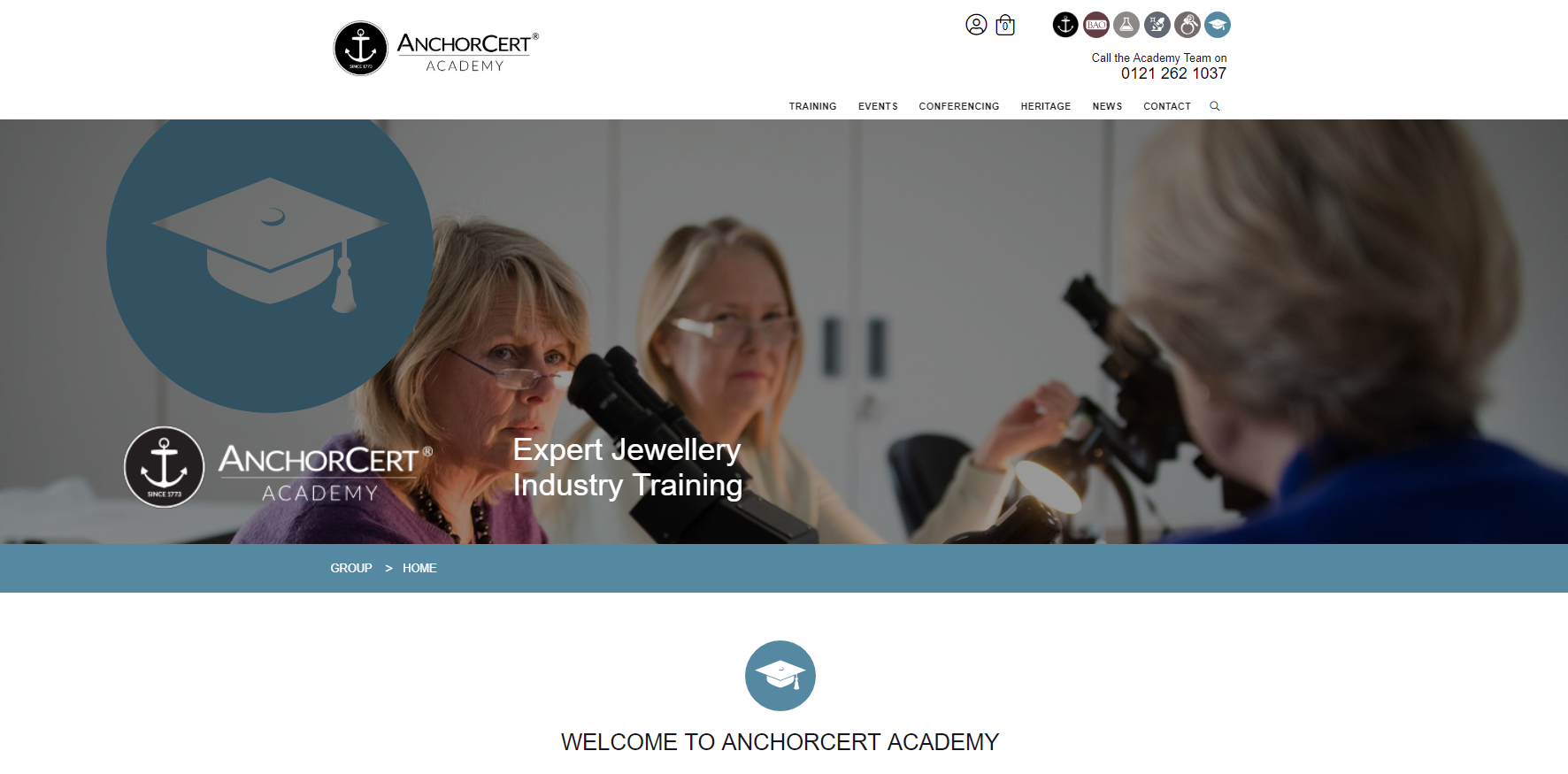 WHEN MICHAEL ALLCHIN JOINED THE BIRMINGHAM ASSAY OFFICE 10 YEARS AGO THERE WAS NO WAY HE COULD HAVE PREDICTED HOW THE INDUSTRY WOULD CHANGE DURING HIS TENURE. HE SPEAKS TO RACHAEL TAYLOR ABOUT ADAPTING TO A LIFE WITH LESS HALLMARKING.
When Michael Allchin joined the Birmingham Assay Office, the price of silver was hovering around the £3 an ounce mark, rather than £21, and the only business that the assay office was interested in was hallmarking; 10 years into the job and his whole working world has been tipped upside down.
Fortunately, the chief executive, who has also worn the hats of sales agent, retailer and multiple retailer buying director, is not adverse to a bit of change. In fact, he thrives on it; but that is not to say that the rapidly evolving jewellery industry has not left him a little stunned.
 âI could not have predicted this,â says Allchin, gesturing behind him towards the halls of  The Jewellery Show during our interview in February. âBut I did realise that it is very dangerous to be a one-trick pony.âÂ
Allchin is visiting the show to deliver a talk to the exhibitionâs visitors about the climate in the jewellery industry, with a focus on precious metals and hallmarking; something that he does regularly. He has built up a long career in the industry, starting out as a rep on the road selling jewellery both in the UK and the US before venturing into the retail side of the business and then moving on to join Signet Group, where he was buying director for H Samuel for 14 years.
In short, Allchin has built up a wealth of knowledge that allows him to better perform his duties as chief executive at the Birmingham Assay Office. More importantly, a long and varied career in the industry has allowed him to document change and recognise the importance of innovating within a business to survive.
âIt is easy to knock the jewellery industry as it has an image that is fuddy duddy, but they are all running businesses and they realise that if they donât change then they will go bust,â he says. âJust look around us here. At Spring Fair 10 years ago there were no brands or silver jewellery. They have embraced change. You see nice jewellers now adopting products like those from Tresor Paris that have no precious metals. It is a business imperative to change, because if they donât they will die.â
It has been a decade since Allchin moved to The Birmingham Assay Office and it is a business hit hard by escalating metals prices. Total hallmarking figures in the UK have been steadily declining since 2003, with the number of gold items hallmarked dipping every year since 2001.
When Allchin joined the Office it was churning through 25 million items of gold jewellery annually, but last year it processed just 4.4 million gold items. Likewise, silver has dropped from 8.7 million in 2002 to 6 million. The total number of items hallmarked last year was just less than 10.9 million versus 34.1 million in 2002 â a drop of nearly 70%.
While hallmarking figures have been in decline, precious metals prices have been on the rise â but this matters little to the Birmingham Assay Office. âGold has gone through the roof, prices have gone up but volumes have gone down and weâre unit driven,â says Allchin. âThe cost of hallmarking as a percentage of what jewellery now costs is negligible.â
WHEN MICHAEL ALLCHIN JOINED THE BIRMINGHAM ASSAY OFFICE 10 YEARS AGO THERE WAS NO WAY HE COULD HAVE PREDICTED HOW THE INDUSTRY WOULD CHANGE DURING HIS TENURE. HE SPEAKS TO RACHAEL TAYLOR ABOUT ADAPTING TO A LIFE WITH LESS HALLMARKING.
When Michael Allchin joined the Birmingham Assay Office, the price of silver was hovering around the £3 an ounce mark, rather than £21, and the only business that the assay office was interested in was hallmarking; 10 years into the job and his whole working world has been tipped upside down.
Fortunately, the chief executive, who has also worn the hats of sales agent, retailer and multiple retailer buying director, is not adverse to a bit of change. In fact, he thrives on it; but that is not to say that the rapidly evolving jewellery industry has not left him a little stunned.
 âI could not have predicted this,â says Allchin, gesturing behind him towards the halls of  The Jewellery Show during our interview in February. âBut I did realise that it is very dangerous to be a one-trick pony.âÂ
Allchin is visiting the show to deliver a talk to the exhibitionâs visitors about the climate in the jewellery industry, with a focus on precious metals and hallmarking; something that he does regularly. He has built up a long career in the industry, starting out as a rep on the road selling jewellery both in the UK and the US before venturing into the retail side of the business and then moving on to join Signet Group, where he was buying director for H Samuel for 14 years.
In short, Allchin has built up a wealth of knowledge that allows him to better perform his duties as chief executive at the Birmingham Assay Office. More importantly, a long and varied career in the industry has allowed him to document change and recognise the importance of innovating within a business to survive.
âIt is easy to knock the jewellery industry as it has an image that is fuddy duddy, but they are all running businesses and they realise that if they donât change then they will go bust,â he says. âJust look around us here. At Spring Fair 10 years ago there were no brands or silver jewellery. They have embraced change. You see nice jewellers now adopting products like those from Tresor Paris that have no precious metals. It is a business imperative to change, because if they donât they will die.â
It has been a decade since Allchin moved to The Birmingham Assay Office and it is a business hit hard by escalating metals prices. Total hallmarking figures in the UK have been steadily declining since 2003, with the number of gold items hallmarked dipping every year since 2001.
When Allchin joined the Office it was churning through 25 million items of gold jewellery annually, but last year it processed just 4.4 million gold items. Likewise, silver has dropped from 8.7 million in 2002 to 6 million. The total number of items hallmarked last year was just less than 10.9 million versus 34.1 million in 2002 â a drop of nearly 70%.
While hallmarking figures have been in decline, precious metals prices have been on the rise â but this matters little to the Birmingham Assay Office. âGold has gone through the roof, prices have gone up but volumes have gone down and weâre unit driven,â says Allchin. âThe cost of hallmarking as a percentage of what jewellery now costs is negligible.â
 As would be normal for any business that has had demand for its services slashed by 70%, the Office has had to loose valued staff members as the hallmarking work dried up. âOver the years we have, unfortunately, had to make some redundancies,â explains Allchin. He says that many of the staff who worked in hallmarking have now since retired, but the redundancies are not a thing of the past â just last month three more people were laid off from the hallmarking division.
But the true crux of the change is not the staff turnover but the fact that hallmarking is now just a division of the Birmingham Assay Office, not its complete offer.
 As Allchin has mentioned, he saw very clearly from the start of his time with the Office that being a one-trick pony was not a strategy that he wanted to follow, and when hallmarking trends revealed themselves to be heading into negative territory, he put a two-pronged action plan into play.
The future-proofing plan had two simple facets â the first being to expand its laboratory beyond the hallmarking of precious metals to incorporate the testing of fashion jewellery, and the second to break into previously untried markets such as diamond certification, jewellery valuations and training.
The first has been a huge success. The fashion jewellery analysis service â which tests costume jewellery to make sure that it is in line with regulations concerning elements like nickel and lead levels â is now reaching a par with the Officeâs precious metals hallmarking business. âFashion jewellery is booming,â says Allchin. âSilver is becoming more expensive so there is a rise in the amount of products that use things like cord and rubber.â
As metal prices push some products and suppliers out of the market, there are many jewellers embracing costume jewellery; but this is a market with rules and regulations all of its own, warns Allchin. âPeople need to be aware of product safety regulations because they are there for a reason,â advises Allchin. âSome of these things can be poisonous, carcinogenic. The big companies like Tesco and M&S that sell a lot of jewellery understand the legislation and testing, but small companies donât understand it as well and they could get themselves into trouble.â
As part of his tour of The Jewellery Show in February, Allchin is venturing out into the fashion accessories hall, which is part of the wider Spring Fair exhibition, to give a talk to fashion and gift retailers about the services that the Birmingham Assay Office can offer them in terms of testing costume jewellery. This talk, he admits, does make him a little more nervous than the talks he gives on fine jewellery because he finds himself slightly out of his comfort zone of technical knowledge, but he assures that he has a dedicated team back in the city that are experts in the field, which leads us to the second prong of the attack on declining hallmarking.Â
Allchin is not the only learned member of the Birmingham Assay Office, it is packed with people who are each experts in their individual jewellery fields. As he puts it: âWe are lucky enough to have some very bright and intelligent people working for us.â
The Birmingham Assay Office has been offering advice to its customers for years, with Allchin always advising hallmarking customers to spend time at the Office and soak up some expertise, but over the past two years it has made moves towards commercialising the bank of knowledge at its fingertips by offering training. So far, the training courses have been sporadic but the Office has just hired someone to look after this division full time. âThere is a demand, so we thought âlets get into this market properlyâ,â he says. âWe offer very commercial courses, not academic course â the scrap buying course has been very popular, for example. People are still willing to spend money on training.â
Other new additions to the offer at the Birmingham Assay Office have included the acquisition of the Safeguard valuation service in 2000, which Allchin says âhas grown substantiallyâ, and the launch of diamond certification business AnchorCert in 2002.
The Office has also started to offer some more novelty services, such as personalised diamond engraving. The service evolved from technology the Office already had in place to engrave certification numbers on diamonds, but it now offers any manner of inscriptions. âWe get asked to engrave some very rude messages,â laughs Allchin. âIt is never going to be a huge part of our business, but it is fun.â
As would be normal for any business that has had demand for its services slashed by 70%, the Office has had to loose valued staff members as the hallmarking work dried up. âOver the years we have, unfortunately, had to make some redundancies,â explains Allchin. He says that many of the staff who worked in hallmarking have now since retired, but the redundancies are not a thing of the past â just last month three more people were laid off from the hallmarking division.
But the true crux of the change is not the staff turnover but the fact that hallmarking is now just a division of the Birmingham Assay Office, not its complete offer.
 As Allchin has mentioned, he saw very clearly from the start of his time with the Office that being a one-trick pony was not a strategy that he wanted to follow, and when hallmarking trends revealed themselves to be heading into negative territory, he put a two-pronged action plan into play.
The future-proofing plan had two simple facets â the first being to expand its laboratory beyond the hallmarking of precious metals to incorporate the testing of fashion jewellery, and the second to break into previously untried markets such as diamond certification, jewellery valuations and training.
The first has been a huge success. The fashion jewellery analysis service â which tests costume jewellery to make sure that it is in line with regulations concerning elements like nickel and lead levels â is now reaching a par with the Officeâs precious metals hallmarking business. âFashion jewellery is booming,â says Allchin. âSilver is becoming more expensive so there is a rise in the amount of products that use things like cord and rubber.â
As metal prices push some products and suppliers out of the market, there are many jewellers embracing costume jewellery; but this is a market with rules and regulations all of its own, warns Allchin. âPeople need to be aware of product safety regulations because they are there for a reason,â advises Allchin. âSome of these things can be poisonous, carcinogenic. The big companies like Tesco and M&S that sell a lot of jewellery understand the legislation and testing, but small companies donât understand it as well and they could get themselves into trouble.â
As part of his tour of The Jewellery Show in February, Allchin is venturing out into the fashion accessories hall, which is part of the wider Spring Fair exhibition, to give a talk to fashion and gift retailers about the services that the Birmingham Assay Office can offer them in terms of testing costume jewellery. This talk, he admits, does make him a little more nervous than the talks he gives on fine jewellery because he finds himself slightly out of his comfort zone of technical knowledge, but he assures that he has a dedicated team back in the city that are experts in the field, which leads us to the second prong of the attack on declining hallmarking.Â
Allchin is not the only learned member of the Birmingham Assay Office, it is packed with people who are each experts in their individual jewellery fields. As he puts it: âWe are lucky enough to have some very bright and intelligent people working for us.â
The Birmingham Assay Office has been offering advice to its customers for years, with Allchin always advising hallmarking customers to spend time at the Office and soak up some expertise, but over the past two years it has made moves towards commercialising the bank of knowledge at its fingertips by offering training. So far, the training courses have been sporadic but the Office has just hired someone to look after this division full time. âThere is a demand, so we thought âlets get into this market properlyâ,â he says. âWe offer very commercial courses, not academic course â the scrap buying course has been very popular, for example. People are still willing to spend money on training.â
Other new additions to the offer at the Birmingham Assay Office have included the acquisition of the Safeguard valuation service in 2000, which Allchin says âhas grown substantiallyâ, and the launch of diamond certification business AnchorCert in 2002.
The Office has also started to offer some more novelty services, such as personalised diamond engraving. The service evolved from technology the Office already had in place to engrave certification numbers on diamonds, but it now offers any manner of inscriptions. âWe get asked to engrave some very rude messages,â laughs Allchin. âIt is never going to be a huge part of our business, but it is fun.â
 And this diversification is at the heart of all that Allchin has planned for the Birmingham Assay Office. He has now reigned over the Office for a decade and at 61 years old his thoughts are turning to retirement, but there is one last major culture change that he wants to put in place first â the opening of a brand new purpose built development to house the business.
The Birmingham Assay Office has been at its current location in the cityâs Jewellery Quarter since 1887 and while the building has a historic charm, it is not fit for purpose for the kind of modern Assay Office that Allchin wants to leave as his legacy. His list of complaints include that the existing building is hard to keep clean, expensive to run, is difficult to secure and the layout of the building means that staff are very segregated as they have to work on separate floors.
Allchin is currently in negotiations with Birmingham City Council to buy a plot of land in the area to build his dream Assay Office, which he hopes will be completed by 2013. The new space will have bright and airy working conditions for staff, who will be able to work together on a single floor per department, will have better training facilities, a larger lab and will also have an exhibition space that will allow the Office to show off its historic silver collection or exhibitions of local design talent more often.
âWe are in the final stage of getting prices and we have done all the right things for planning permission,â says Allchin, who is confident that the project will be signed off without hitch. âWe have made sure that all the senior politicians understand why we need to move, and weâve got their support. The Jewellery Quarter is in Ladywood, which is the most deprived area in the country [in 2010 the constituency was registered as having the highest rate of unemployment of any constituency in the UK] so it is in their interest for us to stay here and keep jobs here.â
Hallmarking has been a long-standing institution and was founded by an act of Parliament in 1773, but despite this stretch of 239 years, Allchin is only the 13th Assay Master of the Birmingham Office and he feels the weight of his historical predecessors and is keen to do them right while carrying the torch for hallmarking.Â
âI feel Iâm holding a baton and I want to make sure that it lasts for a very long time to come,â he says. âI want to get the new build up and running so that when it is time to hand over to the new person I can say âsee, here it is, take itâ.â
The 17th Assay Master may have endured one of the most tumultuous times in hallmarking history but he can be proud when the time comes to cash in his 60-hour working week that he has successfully steered it though choppy waters and helped it to emerge a stronger, more versatile business that is prepared for whatever the jewellery industry has to throw at it in the next decade to come.
ARTICLE TAKEN FROM MARCH 2012 EDITION OF PROFESSIONAL JEWELLER. TO DOWNLOAD A COPY, FOLLOW THIS LINK http://www.professionaljeweller.com/article-11029-read-professional-jewellers-march-issue-online/
[caption id="attachment_1233" align="alignnone" width="265" caption="The Birmingham Assay Office"]
And this diversification is at the heart of all that Allchin has planned for the Birmingham Assay Office. He has now reigned over the Office for a decade and at 61 years old his thoughts are turning to retirement, but there is one last major culture change that he wants to put in place first â the opening of a brand new purpose built development to house the business.
The Birmingham Assay Office has been at its current location in the cityâs Jewellery Quarter since 1887 and while the building has a historic charm, it is not fit for purpose for the kind of modern Assay Office that Allchin wants to leave as his legacy. His list of complaints include that the existing building is hard to keep clean, expensive to run, is difficult to secure and the layout of the building means that staff are very segregated as they have to work on separate floors.
Allchin is currently in negotiations with Birmingham City Council to buy a plot of land in the area to build his dream Assay Office, which he hopes will be completed by 2013. The new space will have bright and airy working conditions for staff, who will be able to work together on a single floor per department, will have better training facilities, a larger lab and will also have an exhibition space that will allow the Office to show off its historic silver collection or exhibitions of local design talent more often.
âWe are in the final stage of getting prices and we have done all the right things for planning permission,â says Allchin, who is confident that the project will be signed off without hitch. âWe have made sure that all the senior politicians understand why we need to move, and weâve got their support. The Jewellery Quarter is in Ladywood, which is the most deprived area in the country [in 2010 the constituency was registered as having the highest rate of unemployment of any constituency in the UK] so it is in their interest for us to stay here and keep jobs here.â
Hallmarking has been a long-standing institution and was founded by an act of Parliament in 1773, but despite this stretch of 239 years, Allchin is only the 13th Assay Master of the Birmingham Office and he feels the weight of his historical predecessors and is keen to do them right while carrying the torch for hallmarking.Â
âI feel Iâm holding a baton and I want to make sure that it lasts for a very long time to come,â he says. âI want to get the new build up and running so that when it is time to hand over to the new person I can say âsee, here it is, take itâ.â
The 17th Assay Master may have endured one of the most tumultuous times in hallmarking history but he can be proud when the time comes to cash in his 60-hour working week that he has successfully steered it though choppy waters and helped it to emerge a stronger, more versatile business that is prepared for whatever the jewellery industry has to throw at it in the next decade to come.
ARTICLE TAKEN FROM MARCH 2012 EDITION OF PROFESSIONAL JEWELLER. TO DOWNLOAD A COPY, FOLLOW THIS LINK http://www.professionaljeweller.com/article-11029-read-professional-jewellers-march-issue-online/
[caption id="attachment_1233" align="alignnone" width="265" caption="The Birmingham Assay Office"] [/caption]
Â
[/caption]
Â

Your item has been added to the basket
You need to create an account, or login before you can add this item to your basket.







